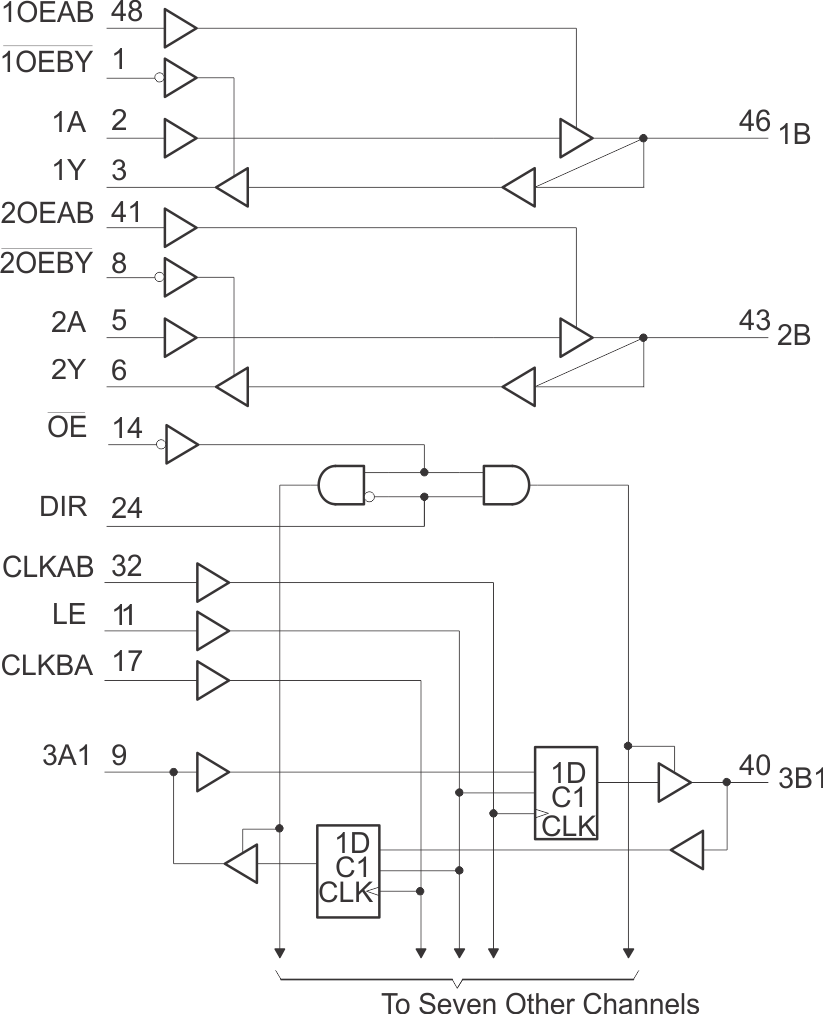SCES625A February 2005 – November 2015 SN74VMEH22501A-EP
PRODUCTION DATA.
- 1 Features
- 2 Applications
- 3 Description
- 4 Revision History
- 5 Description (continued)
- 6 Pin Configuration and Functions
-
7 Specifications
- 7.1 Absolute Maximum Ratings
- 7.2 ESD Ratings
- 7.3 Recommended Operating Conditions
- 7.4 Thermal Information
- 7.5 Electrical Characteristics
- 7.6 Live-Insertion Specifications
- 7.7 Timing Requirements for UBT Transceiver (I Version)
- 7.8 Switching Characteristics for Bus Transceiver Function (I Version)
- 7.9 Switching Characteristics for Bus Transceiver Function (M Version)
- 7.10 Switching Characteristics for UBT Transceiver (I Version)
- 7.11 Switching Characteristics for UBT Transceiver (M Version)
- 7.12 Switching Characteristics for Bus Transceiver Function (I Version)
- 7.13 Switching Characteristics for UBT (I Version)
- 7.14 Switching Characteristics for Bus Transceiver Function (I Version)
- 7.15 Switching Characteristics for UBT (I Version)
- 7.16 Skew Characteristics for Bus Transceiver (I Version)
- 7.17 Skew Characteristics for Bus Transceiver (M Version)
- 7.18 Skew Characteristics for UBT (I Version)
- 7.19 Skew Characteristics for UBT (M Version)
- 7.20 Skew Characteristics for Bus Transceiver (I Version)
- 7.21 Skew Characteristics for UBT (I Version)
- 7.22 Skew Characteristics for Bus Transceiver (I Version)
- 7.23 Skew Characteristics for UBT (I Version)
- 7.24 Maximum Data Transfer Rates
- 7.25 Typical Characteristics
- 8 Parameter Measurement Information
- 9 Detailed Description
- 10Application and Implementation
- 11Power Supply Recommendations
- 12Layout
- 13Device and Documentation Support
- 14Mechanical, Packaging, and Orderable Information
1 Features
- Controlled Baseline
- One Assembly/Test Site, One Fabrication Site
- Enhanced Diminishing Manufacturing Sources (DMS) Support
- Enhanced Product-Change Notification
- Qualification Pedigree(1)
- Member of the Texas Instruments Widebus™ Family
- UBT™ Transceiver Combines D-Type Latches and D-Type Flip-Flops for Operation in Transparent, Latched, or Clocked Modes
- OEC™ Circuitry Improves Signal Integrity and Reduces Electromagnetic Interference (EMI)
- Compliant With VME64, 2eVME, and 2eSST Protocols Validated at TA = –40°C to 85°C
- Bus Transceiver Split LVTTL Port Provides a Feedback Path for Control and Diagnostics Monitoring
- I/O Interfaces are 5-V Tolerant
- B-Port Outputs (–48 mA/64 mA)
- Y and A-Port Outputs (–12 mA/12 mA)
- Ioff, Power-Up 3-State, and BIAS VCC Support Live Insertion
- Bus Hold on 3A-Port Data Inputs
- 26-Ω Equivalent Series Resistor on 3A Ports and Y Outputs
- Flow-Through Architecture Facilitates Printed Circuit Board Layout
- Distributed VCC and GND Pins Minimize High-Speed Switching Noise
- Latch-Up Performance Exceeds 100 mA Per
JESD 78, Class II - ESD Protection Exceeds JESD 22
- 2000-V Human-Body Model (A114-A)
- 200-V Machine Model (A115-A)
- 1000-V Charged-Device Model (C101)
2 Applications
- Industrial Controls
- Telecommunications
- Instrumentation Systems
3 Description
The SN74VMEH22501A-EP 8-bit universal bus transceiver has two integral 1-bit three-wire bus transceivers and is designed for 3.3-V VCC operation with 5-V tolerant inputs. The UBT transceiver allows transparent, latched, and flip-flop modes of data transfer, and the separate LVTTL input and outputs on the bus transceivers provide a feedback path for control and diagnostics monitoring. This device provides a high-speed interface between cards operating at LVTTL logic levels and VME64, VME64x, or VME320(2) backplane topologies.
Device Information(3)
| PART NUMBER | PACKAGE | BODY SIZE (NOM) |
|---|---|---|
| SN74VMEH22501A-EP | TSSOP (48) | 4.40 mm × 9.70 mm |
| TVSOP (48) | 6.10 mm × 12.50 mm |
- Component qualification in accordance with JEDEC and industry standards to ensure reliable operation over an extended temperature range. This includes, but is not limited to, Highly Accelerated Stress Test (HAST) or biased 85/85, temperature cycle, autoclave or unbiased HAST, electromigration, bond intermetallic life, and mold compound life. Such qualification testing should not be viewed as justifying use of this component beyond specified performance and environmental limits.
- VME320 is a patented backplane construction by Arizona Digital, Inc.
- For all available packages, see the orderable addendum at the end of the data sheet.
Logic Diagram (Positive Logic)

Pin numbers shown for DGG and DGV
4 Revision History
Changes from * Revision (February 2005) to A Revision
- Added ESD Ratings table, Feature Description section, Device Functional Modes, Application and Implementation section, Power Supply Recommendations section, Layout section, Device and Documentation Support section, and Mechanical, Packaging, and Orderable Information section Go
- Removed Ordering Information table. Go
- Added junction temperature and removed package thermal impedance from Absolute Maximum Ratings Go
- Added different conditions and results for I and M versions to the Specifications Go
- Updated the VCC test condition for IOZ(PU/PD) Go
- Added Community Resources Go